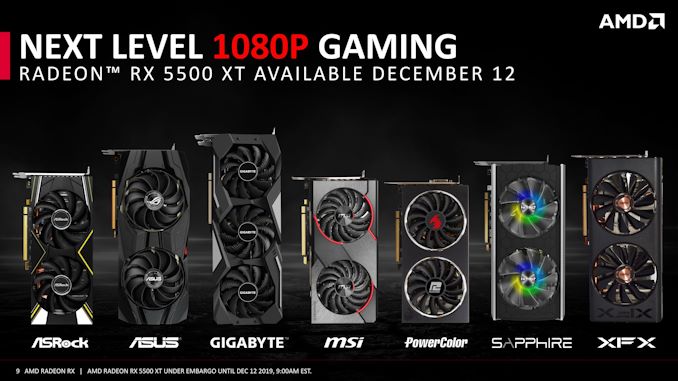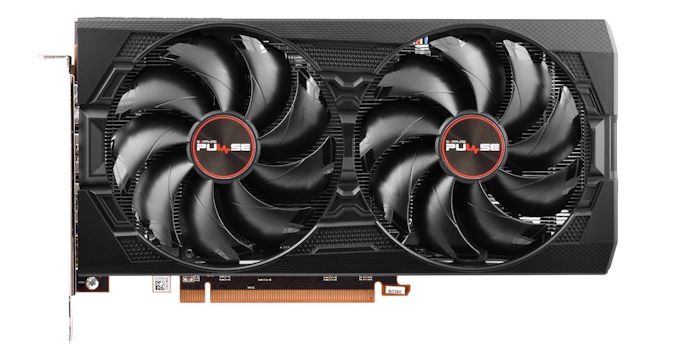The AMD Radeon RX 5500 XT Review, Feat. Sapphire Pulse: Navi For 1080p
by Ryan Smith on December 12, 2019 9:00 AM ESTClosing Thoughts
While the launch of the Radeon RX 5700 series and the underlying Navi 10 GPU was not a slam dunk for AMD’s GPU division, it was none the less an important achievement. The combination of the new RDNA core architecture as well as TSMC’s 7nm process gave AMD a significant kick in both performance efficiency and power efficiency. And in the process, it set a template for all the Radeon RX 5000 series cards to follow.
So it shouldn’t be too surprising then that the new Radeon RX 5500 XT gets to enjoy much the same situation. Compared to AMD’s previous generation Polaris-based RX 500 series cards, the 1080p-focused RX 5500 XT delivers better performance, and it does so while drawing noticeably less power. Even compared to their NVIDIA rivals, AMD is generally competitive on power efficiency in a class of cards where they were well behind in the previous generation.
Competitive performance, meanwhile, is a bit of a trickier subject. As the replacements to the RX 570/580/590 within AMD’s stack, the RX 5500 XT almost always beats AMD’s older cards, the one odd exception to this being Metro Exodus. As a result, AMD’s cheaper 4GB RX 5500 XT looks especially good here, reaching performance parity with NVIDIA’s recently launched and similarly priced GeForce GTX 1650 Super. As is usually the case, the cards are anything but equal on a game-by-game basis, constantly trading wins and losses, but at the end of the day they’re fighting over the same market with the same performance.
The 8GB RX 5500 XT, on the other hand, faces tougher competition. The extra VRAM helps to boost its performance and its price, putting it in competition with NVIDIA’s somewhat awkwardly placed GTX 1660. The GTX 1660 is an odd man out as the only current-generation GDDR5 card among the contenders, and yet it’s still fast enough to remain several percent ahead of the 8GB RX 5500 XT. To be sure, AMD’s new card puts up a great fight, coming closer to meeting NVIDIA in both performance and power efficiency than any previous AMD card; but at the end of the day it’s not enough to completely close the gap with NVIDIA’s closest competitor. Which is not to say that the RX 5500 XT is entirely outclassed here, but the GTX 1660 leads by just enough that it can’t be entirely ignored.
| Performance Summary (1080p) | ||||
| Relative Performance | Relative Price |
|||
| RX 5500 XT 4GB vs GTX 1650S | 0% | +6% | ||
| RX 5500 XT 8GB vs GTX 1660 | -8% | -5% | ||
| RX 5500 XT 8GB vs RX 580 8GB | +8% | +11% | ||
| RX 5700 vs. RX 5500 XT 8GB | +60% | +60% | ||
Throwing a wrench into all of this however – for both AMD and NVIDIA – is VRAM capacity. VRAM isn’t cheap, and GDDR6 even less so, so both vendors are using VRAM capacity as product differentiators and to upsell their better cards. But as VRAM capacity in the $150-$200 price range has been pretty stagnant for the last couple of years now, I do have some concerns about the long-term implications for the 4GB RX 5500 XT, especially with the next-generation consoles set to launch in a year’s time. With the consoles setting the baseline for most multiplatform games, it’s a reasonable bet that VRAM requirements aren’t going to stay put at 4GB much longer. So while the 4GB RX 5500 XT is a great value now, I suspect it’s going to run out of VRAM well before its compute performance gets to be a bottleneck. And while NVIDIA’s GTX 1660 fares better here with its 6GB of VRAM, 6GB is still not 8GB.
Overall then, the VRAM situation adds an extra wrinkle to any kind of product recommendations, as it’s one more variable that deserves consideration.
At the end of the day, I don’t think any 4GB cards are a great choice right now. For buyers who absolutely cannot afford to spend more than $169, then the 4GB RX 5500 XT or NVIDIA’s GeForce GTX 1650 Super counterpart are both going to be the best choices you can make right now, at least among the current-generation cards. However, spending another $30 to get a better card is going to get you a card with at least 6GB of VRAM and 6% more perforamnce, and that’s going to remain relevant for a lot longer than a 4GB card will in 2020.
Choosing between the 8GB RX 5500 XT and GTX 1660, on the other hand, is a bit harder. AMD has a 2GB VRAM advantage, which is likely to be helpful in the future; but right now they can’t match NVIDIA’s performance or feature advantage. Ultimately I’m not sure there’s a clearly correct answer here – at least, not one that can be backed entirely with hard data. In the meantime however, as the second to market it's up to AMD to make a convincing showing if they want to dislodge NVIDIA's existing GTX 1660.
As for Sapphire’s Pulse RX 5500 XT in particular, it’s hard to envision a better card to show off the Radeon RX 5500 XT. If you can look past the card’s somewhat ridiculous size for its class, the product as a whole is just about everything you could want out of a reference clocked card. The build quality is solid, the included TriXX software is handy, and the acoustics are incredible. It may not be a silent card, but with two giant fans to push plenty of air with ease, it may just as well be.
And with that, AMD is set to wrap up their GPU lineup for 2019. At only 3 Navi cards in, AMD is far from done in fleshing out a complete, top-to-bottom family of video cards. But for now, AMD is able to hit the mainstream and performance segments, which is a good place to stop for a bit and reflect as we go into the holidays.












97 Comments
View All Comments
Freeb!rd - Friday, December 13, 2019 - link
For those of us with older cards, I would've appreciated the GTX 1060 6GB & GTX 1070 included in the performance graphs.Freeb!rd - Friday, December 13, 2019 - link
Especially since I have both those and some 580s lying around.sheh - Friday, December 13, 2019 - link
https://www.anandtech.com/bench/product/2577?vs=25...alfatekpt - Friday, December 13, 2019 - link
Depending on price it seems it can actually fight with 1660 Super because the differences are a few FPS with a lower noise/power consumption.ballsystemlord - Saturday, December 14, 2019 - link
@ryan If you can't run opencl on windows why not run your tests on Linux? I'd imagine that some of the programs have a version that runs on Linux.isthisavailable - Saturday, December 14, 2019 - link
The 8 gb version should not exist and the 4gb version should be $10 lower to match 1650super in price while beating it in perf. Why would you buy 8gb version when NVIDIA has 1660 for $10 more.Also, rx5500 gaming laptops when?
Maxxie - Saturday, December 14, 2019 - link
This looks like a gaming card, again. For the professional segment, AMD needs to focus more on compute and reducing operating power/temperature. I was forced to upgrade a working AMD RX 580 4gb to Nvidia's RTX 2060 Super 8gb to get GPU acceleration working in MATLAB. Major benefit the doubled graphics memory, and the new card runs noticeable cooler. Still, I spent $300 on the RX 580 earlier this year wasting a bit of budget. That's going to keep me from trying any AMD cards until they give focus to more than the entertainment segment.dr.denton - Sunday, December 15, 2019 - link
I really don't know much about professional use, but has this not been AMD's biggest problem in the past years? Having GPUs with great compute abilities, but somewhat lacking for gaming?Personally, I'm glad they finally have the ressources to develop two lines of architectures, one focussed on gaming and one for professional use.
ballsystemlord - Saturday, December 14, 2019 - link
One grammar mistake:"...one that TSMC's customers are jockeying to secure wafer starts due to very high demand."
Missing "for":
"...one that TSMC's customers are jockeying to secure wafer starts for due to very high demand."
Father Time - Saturday, December 14, 2019 - link
Closing Thoughts -> 4th last paragraph:"6% more perforamnce".
Great article though.
Does AMD still suffer from Day 1 performance not reflecting the huge gains they get over NVidia as drivers mature? It was a large issue in generations passed (ever since the 2900XT), and considering how close this card is to the NV equivalents, do we expect it to win out over time, or is that a thing of the past now that architecture has changed significantly, along with the technology and the people involved?